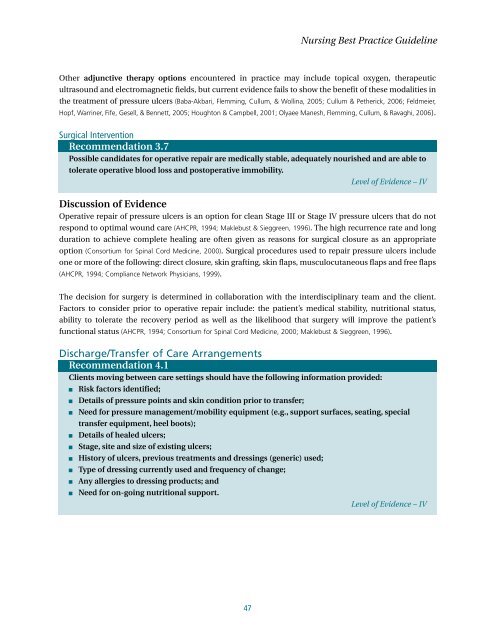Assessment & Management <strong>of</strong> <strong>Stage</strong> I <strong>to</strong> <strong>IV</strong> <strong>Pressure</strong> <strong>Ulcers</strong>changes in calcium homeostasis. Cullum, Nelson and Nixon (2002) identified several RCTs <strong>of</strong> variousquality that indicated that electrotherapy improved healing <strong>of</strong> pressure sores, however suggested a need forfurther confirma<strong>to</strong>ry studies in this area. Most recently, Adunsky & Ohry (2005) conducted a multi-centre,double-blind RCT <strong>to</strong> test electrostimulation therapy with respect <strong>to</strong> rates <strong>of</strong> ulcer closure and wound areareduction. No significant differences between the placebo and treatment group was found, though trends<strong>to</strong>wards a reduction in ulcer area and a faster rate <strong>of</strong> healing for the treatment group during that activephase <strong>of</strong> the treatment was observed.Ultraviolet light C’s inhibi<strong>to</strong>ry effects on bacterial growth are well established and are believed <strong>to</strong> occurthrough direct effects on the nuclear material and bacterial DNA synthesis. There are several clinical reportsthat document the acceleration <strong>of</strong> infected pressure ulcer wound closure with ultraviolet light C treatment(Nussbaum, Blemann, & Mustard, 1994; Thai Thao, Hough<strong>to</strong>n, Keast, Campbell, & Woodbury, 2002; Wills, Anderson, Beattie, &Scott, 1983). In one controlled study <strong>of</strong> chronic pressure ulcers and leg wounds, a significant reduction inpredominant bacteria, including methicillin-resistant Staphylococcus aureus (MRSA), was found after onlyone treatment with ultraviolet light C (Thai Thao, Keast, Campbell, Woodbury & Hough<strong>to</strong>n, 2005).Two randomized trials were found in support <strong>of</strong> warming therapy as an adjunctive treatment for pressureulcers (Kloth, Berman, Nett, Papanek, & Dumit-Minkel, 2002; Witney, Salvadalena, Higa & Mich, 2001). In both studies,1-hour treatment with noncontact normothermic wound therapy (NNWT) three times daily was compared<strong>to</strong> standard care with moisture-retentive dressing, resulting in significant increases in wound healing ratesin the treatment groups.Oving<strong>to</strong>n (1999), in her review <strong>of</strong> the 1994 AHCPR adjunctive therapy recommendations, indicated growthfac<strong>to</strong>rs and skin equivalents as valid and potential pressure ulcer therapies, but also cautioned that thereare many different growth fac<strong>to</strong>rs and skin equivalents, with little data specific <strong>to</strong> their use in pressureulcers. However, literature support for the use <strong>of</strong> growth fac<strong>to</strong>rs in particular, is increasing. In the samereview, Oving<strong>to</strong>n (1999) does provide examples <strong>of</strong> several clinical studies examining the use <strong>of</strong> individualgrowth fac<strong>to</strong>rs and suggests that the use <strong>of</strong> rPDGF-BB (homodimeric recombinant platelet-derived growthfac<strong>to</strong>r) is supported by well-conducted clinical trials. More recently, a randomized, double-blind, placebocontrolledstudy (Landi, Aloe, Russo, Cesari, Onder, Bonini, et al., 2003) found <strong>to</strong>pical application <strong>of</strong> nerve growthfac<strong>to</strong>r significantly reduced the pressure ulcer area in comparison <strong>to</strong> the placebo group.Negative pressure wound therapy involves negative pressure (suction) being applied <strong>to</strong> a wound through anopen cell dressing (e.g., foam, felt). Cullum and Petherick (2006) found two systematic reviews related <strong>to</strong>vacuum assisted closure. Although two randomized controlled trials found that <strong>to</strong>pical negative pressuredecreased wound volume, both reviews concluded that there was no clear evidence <strong>of</strong> improved healing (Evans& Land, 2002; Samson, Lefevre, & Aronson, 2004). The effect <strong>of</strong> vacuum closure on cost, quality <strong>of</strong> life, pain andcomfort were not reported in the literature. Further, it was not possible <strong>to</strong> determine the optimum regimen.Hyperbaric oxygen therapy is considered useful in ischemic wounds <strong>to</strong> provide the oxygen needed <strong>to</strong>support wound healing processes and <strong>to</strong> fight infection. In a systematic review <strong>of</strong> hyperbaric oxygen forchronic wounds, Roeckl-Wiedmann, Bennett and Kranke (2005) found a significant reduction in risk <strong>of</strong>amputation for diabetic wounds treated with this modality, but were unable <strong>to</strong> identify any appropriatetrials with regards <strong>to</strong> treatment <strong>of</strong> pressure ulcers.46
Nursing Best Practice GuidelineOther adjunctive therapy options encountered in practice may include <strong>to</strong>pical oxygen, therapeuticultrasound and electromagnetic fields, but current evidence fails <strong>to</strong> show the benefit <strong>of</strong> these modalities inthe treatment <strong>of</strong> pressure ulcers (Baba-Akbari, Flemming, Cullum, & Wollina, 2005; Cullum & Petherick, 2006; Feldmeier,Hopf, Warriner, Fife, Gesell, & Bennett, 2005; Hough<strong>to</strong>n & Campbell, 2001; Olyaee Manesh, Flemming, Cullum, & Ravaghi, 2006).Surgical InterventionRecommendation 3.7Possible candidates for operative repair are medically stable, adequately nourished and are able <strong>to</strong><strong>to</strong>lerate operative blood loss and pos<strong>to</strong>perative immobility.Level <strong>of</strong> Evidence – <strong>IV</strong>Discussion <strong>of</strong> EvidenceOperative repair <strong>of</strong> pressure ulcers is an option for clean <strong>Stage</strong> III or <strong>Stage</strong> <strong>IV</strong> pressure ulcers that do notrespond <strong>to</strong> optimal wound care (AHCPR, 1994; Maklebust & Sieggreen, 1996). The high recurrence rate and longduration <strong>to</strong> achieve complete healing are <strong>of</strong>ten given as reasons for surgical closure as an appropriateoption (Consortium for Spinal Cord Medicine, 2000). Surgical procedures used <strong>to</strong> repair pressure ulcers includeone or more <strong>of</strong> the following: direct closure, skin grafting, skin flaps, musculocutaneous flaps and free flaps(AHCPR, 1994; Compliance Network Physicians, 1999).The decision for surgery is determined in collaboration with the interdisciplinary team and the client.Fac<strong>to</strong>rs <strong>to</strong> consider prior <strong>to</strong> operative repair include: the patient’s medical stability, nutritional status,ability <strong>to</strong> <strong>to</strong>lerate the recovery period as well as the likelihood that surgery will improve the patient’sfunctional status (AHCPR, 1994; Consortium for Spinal Cord Medicine, 2000; Maklebust & Sieggreen, 1996).Discharge/Transfer <strong>of</strong> Care ArrangementsRecommendation 4.1Clients moving between care settings should have the following information provided:■■■■■■■■■Risk fac<strong>to</strong>rs identified;Details <strong>of</strong> pressure points and skin condition prior <strong>to</strong> transfer;Need for pressure management/mobility equipment (e.g., support surfaces, seating, specialtransfer equipment, heel boots);Details <strong>of</strong> healed ulcers;<strong>Stage</strong>, site and size <strong>of</strong> existing ulcers;His<strong>to</strong>ry <strong>of</strong> ulcers, previous treatments and dressings (generic) used;Type <strong>of</strong> dressing currently used and frequency <strong>of</strong> change;Any allergies <strong>to</strong> dressing products; andNeed for on-going nutritional support.Level <strong>of</strong> Evidence – <strong>IV</strong>47
















